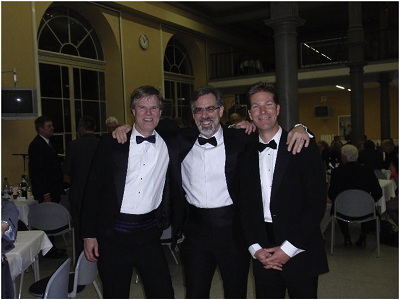A recently published tribute to long time faculty member and Duke Ophthalmology leader, R. Rand Allingham, MD published in Experimental Eye Research special issue on ocular genetics that is dedicated to Dr. Allingham.
The field of glaucoma lost one of its shining stars when Robert Rand Allingham passed away on August 27, 2018. Rand was the first Richard and Kit Barkhouser Professor of Ophthalmology at Duke, serving as the Chief of the Glaucoma Service from 1996 to 2015. In addition to growing the Duke Glaucoma Service into one of the world's premiere programs, Rand was a gifted teacher, an insightful clinician and a formidable researcher, maintaining a cutting-edge research program for over two decades. In short, he was a rare “quadruple threat” in glaucoma, with passion and talent for administration, education, research and patient care.
Rand was a brilliant doctor. He began his medical career as a family practitioner, but became intrigued by the complexity of the eye, doing a second residency in ophthalmology and then a fellowship in glaucoma. Rand was drawn to treating glaucoma because these blinding diseases required thoughtful management over a patient's lifetime, much like family practice. Rand's acumen in the clinical management of glaucoma was recognized by his induction into the American Ophthalmological Society in 2008 and highlighted by invitations over the past two decades to serve as editor for three prestigious clinical book series. Specifically, he was section editor for glaucoma in Albert and Jakobeic's Principles and Practice of Ophthalmology; served as co-editor (with David Epstein and Joel Schuman) for Chandler & Grant's Glaucoma; and, upon request from Bruce Shields, took over as senior editor for three editions of Shield's Textbook of Glaucoma.
Rand was a voracious reader, which together with his clinical practice, made him curious about the genetic underpinnings of different types of glaucoma. At the time that molecular biology and genetics were moving to the scientific forefront, he partnered with geneticists, statisticians and fellow clinician-scientists dedicated to identifying the specific genes that impart risk for the complex group of diseases collectively known as glaucoma. Because of efforts by Rand and his colleagues, over 10,000 individuals have been enrolled in the Duke Glaucoma Genetics Project, with samples collected in the U.S. and beyond (Iceland, Philippines, Mexico, India, and Africa). In the mid 1990's, Rand began work on what would later become one of his greatest passions—understanding the clinical course and genetics of glaucoma in West Africa, decades before the importance of this work was generally recognized. Beginning in Ghana, Rand began collecting clinical data and blood. Later, he and his longtime colleague Michael Hauser expanded this effort to include sample collections from Nigeria, South Africa, Malawi, and many other countries. Study of these samples has revealed that African glaucoma is distinct from glaucoma in other parts of the world, both clinically and genetically. Moreover, this new information will likely lead to changes in the way glaucoma is treated in those of African ancestry. Because of Rand's efforts in Africa and elsewhere, many new genes that associate with risk of glaucoma have been identified, which will serve as a long-term foundation to better understand the pathology of glaucoma.
In addition to genetic causes and clinical management of glaucoma, Rand made several seminal observations over his career, both basic and clinical in nature. For example, working as a research fellow with David Epstein, Rand was the first to report on the relationship between pore density in the inner wall of Schlemm's canal and outflow facility, finding decreased pore numbers and a smaller Schlemm's canal size in glaucoma patients. Subsequently, Rand pioneered work identifying novel glaucoma risk factors, including thinner corneas and lower cerebrospinal fluid pressure. Rand was also passionate about understanding the pathobiology of pseudoexfoliation glaucoma, an unusual type of glaucoma where a single nucleotide change in the lysyl oxidase like-1 (LOXL-1) locus can impart risk in one population and protection in another. This led to the identification of a functional, long non-coding RNA at the LOXL-1 locus, which appears to regulate hundreds of genes, including LOXL-1. As of the date of this memoriam, Rand's original contributions to science number over 200, having been cited over 6000 times.
Beyond his departmental responsibilities, his clinical practice and scientific pursuits, Rand was a mentor to generations of medical students, residents, fellows and junior faculty who passed through Duke Eye Center. His passion was contagious, with many of his trainees seeking academic careers and becoming leaders in the field. Rand was also the consummate networker, enthusiastically supporting novel research ideas, identifying unsolved clinical and basic science problems, and working to connect the very best teams to tackle the big unsolved problems in the field. His warm personality, wonderful sense of humor, and gentle nature were infectious, and his networking led indirectly to many discoveries; in these, Rand was not necessarily a member of the research team, but a catalyst to the team's creation.
Rand was not one to seek out the spotlight, and hence not everyone is aware of his many contributions. This special issue has thus been assembled to honor his legacy. His enthusiasm, passion and thoughtfulness made Dr. Rand Allingham a remarkable clinician-scientist, colleague, mentor and friend, and he is deeply missed.
